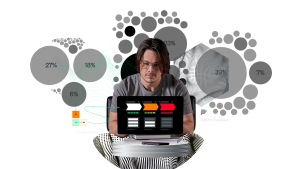Businesses today operate in an intricate digital landscape where applications are the backbone of day-to-day operations. Ensuring the seamless performance of these applications is critical for maintaining productivity and enhancing user experiences. This article explores the significance of business application monitoring, delving into its key components, benefits, and best practices.
What is business application monitoring?
Business application monitoring involves the systematic tracking and analysis of an organization's applications to ensure optimal performance and efficiency. This proactive approach is essential in today's digital landscape, where applications drive business processes. Key metrics, such as response times, error rates, and throughput, are monitored to provide valuable insights into the health and functionality of applications.
Benefits of business application monitoring
Here are some of the benefits of business application monitoring:
- Improved efficiency and productivity: Effective monitoring leads to streamlined workflows, identifying bottlenecks, and enhancing overall operational efficiency. By pinpointing performance issues early, teams can address them swiftly, reducing downtime and improving productivity.
- Enhanced user experience and customer satisfaction: Monitoring tools help maintain a positive user experience by ensuring applications are responsive and error-free. Satisfied users contribute to improved customer loyalty and brand reputation.
- Cost reduction and resource optimization: Identifying and rectifying performance issues early on prevents potential revenue loss associated with downtime. Additionally, resource utilization can be optimized, reducing unnecessary expenses.
- Proactive issue resolution and downtime prevention: With real-time monitoring, organizations can detect and address issues before they impact users. Proactive measures prevent downtime, ensuring continuous business operations.
Implementing business application monitoring into your workflows
There are four key steps to implementing effective business application monitoring:
- Set clear objectives and goals: Define what aspects of application performance are crucial for your business goals.
- Choose the right monitoring tools and software: Select business observability tools that align with your objectives and offer comprehensive insights.
- Define key performance indicators (KPIs): Establish KPIs to measure the success of your monitoring efforts.
- Establish alerts and notifications systems: Implement alerts for immediate response to critical issues.
Best practices for application monitoring and management
Let’s dive into some of the best practices for business application monitoring.
Continuous monitoring vs. periodic monitoring
Continuous monitoring involves real-time tracking of application performance, providing immediate insights into issues as they arise. New Relic excels in continuous monitoring, offering a suite of tools that deliver real-time data on various metrics. The application performance monitoring (APM) feature provides continuous visibility into performance, allowing teams to identify and address issues proactively.
Periodic monitoring, on the other hand, involves intermittent checks at predefined intervals. While it may offer a snapshot of application health, it lacks the immediacy of continuous monitoring. New Relic's approach emphasizes continuous monitoring to ensure that organizations have a dynamic, up-to-the-minute understanding of their application landscapes.
Scalability and flexibility in monitoring solutions
Whether you're a startup experiencing rapid growth or an enterprise managing complex application landscapes, monitoring tools can accommodate your evolving needs. The New Relic platform's scalability ensures that you can continue to monitor and manage applications effectively, regardless of size.
The platform also supports diverse application architectures, from monoliths to microservices, and offers compatibility with various programming languages. This flexibility enables organizations to tailor their monitoring approach to suit their specific tech stacks and application structures.
Collaboration between IT and business teams
Effective collaboration between IT and business teams is a cornerstone of successful application monitoring and management. New Relic facilitates this collaboration through features that provide a common language for both technical and non-technical stakeholders. For example, New Relic dashboards and reports offer visual representations of application performance metrics. These visuals are accessible and comprehensible, ensuring that both IT and business teams can work together to address performance issues and make informed decisions based on monitoring data.
The correlation between monitoring and business performance
Business performance monitoring plays a pivotal role in data-driven decision-making. Insights derived from monitoring efforts guide strategic choices for improved business outcomes. Successful organizations also align performance metrics with overarching business objectives to ensure that monitoring efforts contribute directly to business success. Integrating business intelligence and analytics with monitoring data provides a comprehensive view, enabling informed decision-making for sustained growth.
Tools like New Relic Pathpoint merge customer, product, and services paths into a single business journey, while providing you with visibility into how your applications and infrastructure impact your business, so you can make data-driven decisions and achieve significant financial gains.
Conclusion
Business application monitoring is imperative for optimizing workflows and achieving operational excellence. Embrace the power of application performance monitoring and management to drive efficiency, enhance user experiences, and ensure business success.
Next steps
New Relic stands as the ideal business application monitoring solution, offering comprehensive tools and insights for maintaining and enhancing user experiences.
Ready to elevate your business operations to new heights? Join the legion of successful organizations harnessing the power of New Relic for unparalleled application monitoring and management. Don't let performance issues hinder your growth. Embrace efficiency, enhance user satisfaction, and drive your business forward with New Relic. Sign up for free today.
The views expressed on this blog are those of the author and do not necessarily reflect the views of New Relic. Any solutions offered by the author are environment-specific and not part of the commercial solutions or support offered by New Relic. Please join us exclusively at the Explorers Hub (discuss.newrelic.com) for questions and support related to this blog post. This blog may contain links to content on third-party sites. By providing such links, New Relic does not adopt, guarantee, approve or endorse the information, views or products available on such sites.



